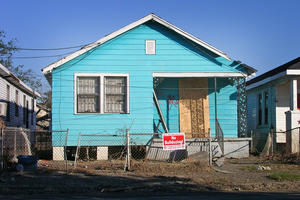Holy Cross, named for a Catholic school built there in 1879, is one of many local and National Register Historic Districts in New Orleans. Architecturally, the neighborhood is defined by nineteenth- and early twentieth-century “shotgun” houses, Creole cottages, and postwar suburban ranch houses. New Orleans’ Lower Ninth Ward was devastated by Hurricane Katrina in 2005. The ward is closer to the mouth of the Mississippi River, and downriver from the New Orleans Industrial Canal (whose broken levees were responsible for much of the damage), than many of New Orleans’ other neighborhoods. Holy Cross, a sub-district of the Lower Ninth Ward, also suffered damage, yet most of its 2,000 properties remained intact.
Encouraging alternatives to the demolition of damaged structures
In 2008, the Historic Neighborhoods of New Orleans was included on the World Monuments Watch. Subsequently, in partnership with the Preservation Trades Network, the University of Florida, the American College of the Building Arts, and the Holy Cross Neighborhood Association, we developed an eight-week interdisciplinary, project-based field school in the Holy Cross neighborhood. Bringing together trade students and apprentices, as well as graduate students in historic preservation, architecture, engineering, and allied fields, the field school focused on working with green design and sustainable construction techniques in a post-disaster environment. Participants surveyed and documented historic structures, explored methodologies for sustainable rehabilitation, and participated in hands-on efforts to repair damaged structures.
In 2009, we continued to work with Preservation Trades Network, supporting students working on the historic Taylor Tomb in Lafayette Cemetery, one of the oldest cemeteries in the region and a 1996 World Monuments Watch site. Through this initiative, we encouraged alternatives to the demolition of damaged structures. Partnering with local organizations and leading preservation programs, we supported training in sustainable preservation methods and approaches, and encouraged green building techniques in the region. Thus the success of the field schools was two-fold: structures were analyzed and rehabilitated to the benefit of the local community, and future designers were endowed with a new set of “best practice” preservation skills.

